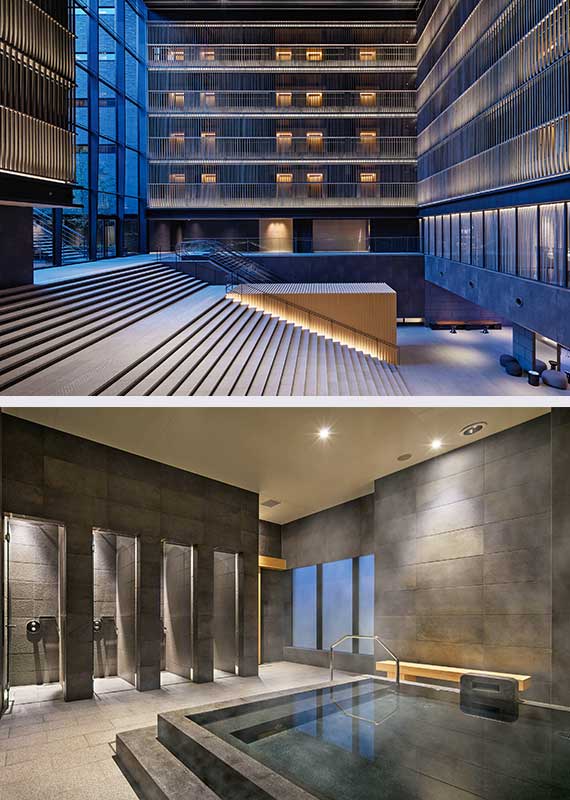From centuries old traditions to futuristic modern technology and lush natural beauty, Japan is a beguiling holiday destination that is like no other
When I tell friends I am visiting Japan the response is a mix of awe and envy. Offering a unique and fascinating blend of ancient traditions and cutting-edge modernity, the country has been on my holiday bucket list for some time. And having read much about the diverse cultural heritage, from ancient temples and shrines to the traditional arts such as tea ceremonies and calligraphy, it’s difficult to pin down what I’m looking forward to the most when I finally get around to planning my own trip.
I’m booked to fly from London Heathrow to Nagoya, via Helsinki, with Finnair; it is the only airline to connect Europe to the Japanese city, operating flights twice a week. Feeling celebratory, I start the trip with a glass of chilled Champagne in the Cathay Pacific Lounge in Terminal 3, toasting my good fortune. The hop over to Helsinki takes less than three hours and the views of beautiful fjords and forests on the final approach are spectacular. On arrival, we head straight to the Finnair Lounge, which is fittingly decorated in muted forest greens.
Excitingly, we’re booked to fly Business Class for the next leg. Finnair have just introduced an innovative seat design offering a spacious, lay-flat bed experience with a contoured shell design that enhances privacy and comfort. It feels like the height of luxury, and the personal TV screen is the biggest I’ve ever seen on a plane, offering an excellent selection of entertainment options. The overnight flight is almost 13 hours long and miraculously I manage to get some shut-eye, which speaks volumes as I’m usually a terrible plane sleeper. The service is friendly and warm, and the menus are varied (in fact, if you pre-order there are plentiful options for all dietary requirements). With Marimekko-designed textiles (and a lovely kit bag) for a Nordic-inspired luxury feel, I don’t really want the flight to end!

We’ve heard that Japan can feel bewildering to first time visitors, so have enlisted the services of Kinga Ciupak, a guide from tour company InsideJapan. Train travel here, especially from Meitetsu Nagoya station, which is literally next door to the hotel, is fast, clean and very efficient. And Kinga makes life very easy, providing us with a pre-loaded IC Transport Card (like London’s Oyster card). We head out to Inuyama Castle, one of Japan’s oldest surviving castles and a striking example of traditional Japanese architecture. Located in Inuyama, a small city in the Aichi prefecture, just north of Nagoya, the 17th century castle is a popular destination for those wanting to discover more about Japan’s feudal past. When it was built in the late 1580s there were 3,000 castles in Japan, but feudal and world wars destroyed all but 12, and this is the oldest of those that are left. We also stop off at the Jo-an Tea Ceremony House, built in 1618 and now designated a National Treasure. Here, we drink matcha tea in a replica house in the grounds, learning about the fascinating culture of tea drinking. We’re told that warriors would leave their samurai swords outside before drinking tea together.
Afterwards, we walk up to the Sanko Inari Shrine, a small but charming structure, dedicated to Inari, the Shinto deity of fertility, rice, agriculture, and foxes. Inari shrines are common throughout Japan, and Sanko Inari is one of the many dedicated to this important deity, revered for bringing prosperity and protection. One of the most striking features is its series of bright red torii gates, which visitors pass through as they approach. These gates are symbolic of the transition from the mundane to the sacred. Visitors often come to pray for good fortune: we purchase ‘money’ that we are then able to ‘wash’ in a bamboo bowl for good luck, and then write messages on charms which we leave behind. Next up, it’s Osu Kannon, a vibrant and eclectic area in Nagoya, centred around the historic Osu Kannon Temple. It is also home to a very cool shopping district, full of vintage shops – oh for a bigger case to bring back a kimono or two!

The next day we pack our cases and take a train to Hida-Furukawa. The views on the way are incredible, with vistas of lush forests, pine trees, bamboo plants, mountains and the fast-flowing Kiso River. And we are thrilled to discover that you can swivel the train seats to better appreciate the views (or possibly to ensure that passengers can always face the direction of travel, but I prefer my explanation!).
Set in the mountains of the northern Gifu prefecture, Hida-Furukawa’s historic, canal-lined streets, temples and museums bring a lovely sense of peace. We are delighted by the small canals full of Koi carp that flow through the streets. There are over 1,000 Koi here, and every year they are taken out of the canal by hand and delivered safely to a nearby pond to hibernate over winter. The smalltown feels like a film set; the buildings designed in a samurai house style. Keen to learn more about the town, we pay a visit to the Hida-Furukawa Matsuri Kaikan museum, which gives us a fascinating insight into the famous festival that takes place in the town every April. There are stunning displays of the beautifully elaborate floats used in the event.
It feels like a real privilege to have a peek into such a unique local custom, and as it’s off the standard tourist route, it feels even more special. Our next stop is the neighbouring, larger town of Hida-Takayama, where we are staying in the Tokyu Stay Hotel. We are excited to try out the hotel’s onsen baths, having seen a preview on the recent series of BBC One’s Race Across the World. We’re asked to strip off entirely, and then sit on a tiny plastic stool to wash thoroughly before stepping into the hot bath, which takes more than a little courage in front of strangers, but it does feel like a big tick off the experiences list. And dinner that evening, at a restaurant called Karakuri, proves another such experience. Removing our shoes and sitting on the floor on Tatami mats, we cook slices of tender Hida beef on our own little griddle pans.
Rising early the next morning, we head to the Miyagawa Morning Market, where locals come to meet friends and buy local produce. Stalls are set up alongside the river, and we buy local honey and people-watch before heading back to collect our cases and continue our adventures. Excitement levels are high – we are travelling back to Nagoya where we will transfer onto the Shinkansen, aka the Bullet Train, to Kyoto. Taking just 34 minutes, the journey is fast and fun, and we tuck into pretty bento boxes while we watch the rice fields speed by.

Now seen as the cultural capital of Japan, Kyoto was the country’s imperial capital for over 1,000 years. Surrounded by mountains on three sides, it is approximately 320 square miles in size, and home to around 1.45 million residents (plus plenty of visitors). And with an incredible 1,600 temples, it packs a lot in. The great thing about having a guide is that, armed with all the insider information on the best times to visit the more popular sites, she ensures we avoid the crowds. Before we hit our first temple, we check into The Thousand Kyoto, an incredibly glamorous member of Preferred Hotels & Resorts, situated right next to the station. It is so cool, in fact, that we struggle to find the entrance, believing we have wrongly wandered into an art gallery.
Flooded with natural light and adorned with abundant greenery, minimalist comfort is the concept here. The rooms are beautiful and the bed so comfortable that we manage to sleep through a minor earthquake – albeit a common event that doesn’t trouble the locals.
We are here for the temples, and we are spoilt for choice. Ninth century Eikando Temple is filled with various works of art, the most notable of which is a statue of the Amida Buddha with his head turned to one side rather than facing forward as he is usually portrayed. Legend has it that a head monk was performing a ritual for the statue when it turned to face him and spoke to him. Indeed, every temple we visit has a wonderful story or legend attached, which makes Japan even more fascinating. The gardens here are lush and serene, and as the rain starts to fall, it only adds to the Zen like atmosphere.
Tenryu-ji Temple, in Kyoto’s Arashiyama district, is one of the major Zen Buddhist temples. Founded in 1339 it is now a UNESCO World Heritage Site. This is the busiest area we visit, but it’s easy to see why as it is so beautiful. A short walk from Tenryuji, is Arashiyama Bamboo Grove, an iconic bamboo forest famous for its peaceful ambience and scenic paths. The surrounding streets are lined with traditional tea houses, restaurants, and shops. One of my favourite moments is talking to an elderly gentleman selling pretty postcards on a path near the temple. He excitedly asks us where we are from, pulling out a well-thumbed atlas and a pen and then circling London. He’s got circles all over the map and his simple joy in marking the homes of the people he meets every day is a reminder to appreciate the small things in life.

Historic Gion, Kyoto’s geisha (geiko) district, is a picturesque area famous for its traditional wooden machiya houses, tea houses, and narrow streets. Here, InsideJapan have arranged for us to meet an apprentice geiko (known by the title of maiko). This offers a wonderful insight into an ancient and often misunderstood culture. Just 18 years old and dressed in an elegant kimono, Katsuide is gentle and smiles shyly as she tells us about the five years of training she in undergoing. One detail that stays in my mind is that she is required to sleep using a wooden block as a pillow to keep her hair in place! As a qualified geiko she’ll be allowed to wear a wig.
We couldn’t leave Japan without a meal involving a conveyor belt, so we pop into Musashi Sushi and watch as the plates stack up. Incredible cuts of tuna and salmon roll by… and later, we roll out, happily stuffed.
Sadly, the time comes to check out of the wonderful One Thousand Kyoto. We have time to spare at Nagoya Station – as luck would have it, it’s home to a huge shopping mall, and we are keen to spend our last Yen. Left to our own devices as Kinga kindly looks after our cases, we tackle eating out and shopping alone for the first time in Japan. Illustrating just how invaluable Kinga has been, some members of the group find themselves thoroughly lost. Note to self, always stick with the guide!
Japan has exceeded all our expectations. It offers a fascinating blend of modern and traditional, and the people are not only friendly and welcoming, but bring a playful spirit to everyday interactions. Indeed, the only thing stopping us from being too sad about leaving is the fact that we have the luxury of a return journey in Business Class with Finnair to look forward to. Champagne and a good night’s sleep await.

